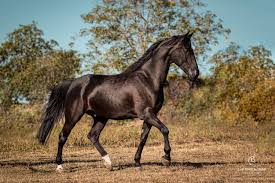
Maremmano
Conditions of detention
Maremmano horses are highly adaptable and can thrive in various environments, though they are particularly well-suited to outdoor living in regions with similar climates to their native Maremma. They do well in large pastures where they can move freely, but they also require access to shelter to protect them from extreme weather conditions.
Useful Fact: Maremmanos are hardy horses that can live outside year-round, provided they have access to shelter and adequate forage, making them ideal for extensive grazing systems.
Nutrition and diet
Maremmanos are easy keepers and can maintain their condition on a diet of high-quality forage, such as hay and pasture. They generally require minimal grain supplementation unless they are in heavy work or have specific nutritional needs.
Useful Fact: The breed’s origins in a harsh environment have led to a metabolism that efficiently converts forage into energy, meaning they often require less supplementary feed than other breeds.
Health
Maremmano horses are known for their robust health and longevity. They are generally free from hereditary health issues and have a strong constitution. Regular veterinary care, including vaccinations, deworming, and dental checks, is important to maintain their health.
Useful Fact: Maremmanos’ strong hooves and durable joints, developed from working in rugged terrain, make them less prone to lameness and other common equine issues.
Grooming and care
Maremmanos require regular grooming to keep their coats clean and healthy. Their manes and tails, while not particularly prone to tangling, should still be brushed regularly. Regular hoof care is essential, especially if they are working on hard or rocky terrain.
Useful Fact: Given their outdoor lifestyle, Maremmanos often develop a thick, protective coat in winter, which requires more grooming during shedding seasons to keep them comfortable and prevent skin issues.
Education and training
Maremmano horses are intelligent and quick to learn, making them relatively easy to train. They are traditionally used for cattle herding and riding but can also be trained for a variety of equestrian disciplines, including dressage and eventing. Their calm temperament makes them suitable for riders of all experience levels.
Useful Fact: The Maremmano’s historical use in herding has made it particularly adept at working with livestock, and they often excel in disciplines that require agility and quick thinking.
Toys and entertainment
Maremmanos enjoy mental and physical stimulation, which can be provided through activities like trail riding, obstacle courses, or even working with cattle. Toys that encourage problem-solving, such as treat balls, can also be beneficial.
Useful Fact: Maremmanos are naturally curious and benefit from activities that mimic their traditional work, such as herding or navigating challenging terrain, which helps keep them mentally and physically engaged.
Safety
Maremmanos are calm, steady horses that are generally safe to handle. However, as with any horse, secure fencing and a safe environment are essential to prevent accidents. They should be housed in well-maintained facilities that minimize the risk of injury.
Useful Fact: Maremmanos’ calm demeanor and strong bond with their handlers contribute to their overall safety, making them less prone to panic in unfamiliar situations.
Accessories
Maremmano horses require standard tack, including well-fitted saddles and bridles. Due to their strong, muscular build, tack should be chosen to ensure comfort, especially for long rides or heavy work. Protective leg gear may be needed if they are used for activities like herding or jumping.
Useful Fact: Because of their strong necks and broad chests, Maremmanos may require custom-fitted or adjustable tack to ensure it fits comfortably and does not restrict movement.
Socialization
Maremmanos are social animals that thrive on interaction with both humans and other horses. They do well in herd environments and enjoy the companionship of other horses, which helps them maintain their mental well-being.
Useful Fact: The breed’s historical use in close contact with humans has made Maremmanos particularly good at forming strong bonds with their handlers, making regular social interaction important for their emotional health.
Travel and Transportation
Maremmanos generally travel well, thanks to their calm temperament. They require a comfortable, well-ventilated trailer with enough space to stand securely during transport. Regular stops during long journeys for water and rest are important.
Useful Fact: Maremmanos’ calm nature often makes them easier to load and transport, reducing stress during travel compared to more high-strung breeds.
Behavior and psychology
Maremmano horses are known for their calm, intelligent, and hardworking nature. They are reliable and steady, with a strong work ethic that has been honed through centuries of use in demanding environments. Their temperament makes them suitable for a variety of roles, from work to leisure riding.
Useful Fact: Maremmanos are often described as having a “no-nonsense” attitude, making them dependable and trustworthy partners, particularly in challenging or unpredictable environments.
Legal aspects
Owning a Maremmano horse may involve specific legal considerations, particularly if they are used in breeding or competition. Registration with relevant breed organizations, such as the Italian National Horse Breeders Association (ANAM), ensures that the horse’s lineage is documented. Compliance with local animal welfare laws is also essential.
Useful Fact: Maremmanos are part of Italy’s cultural heritage, and efforts to preserve and promote the breed include initiatives to document and register individual horses, helping to maintain their purity and historical significance.


